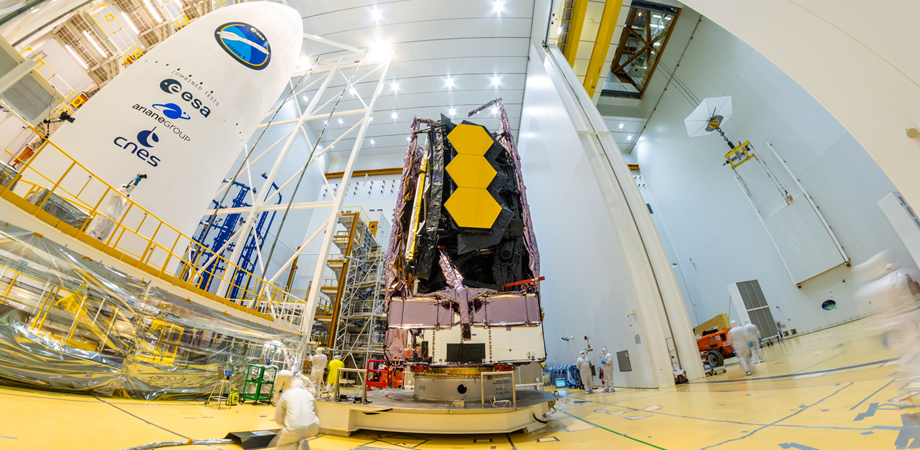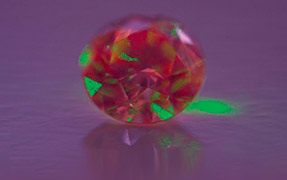Webb: Risky business will be worth the wait

Yes it is massively over budget and, yes, it is more than a decade late. But as the Ariane 5 rocket carrying the James Webb Space Telescope (JWST) into space cleared the tower early on Christmas morning, it was impossible not to feel a rush of excitement.
What has become an absurdly complex engineering challenge arrived at the "L2" Lagrange point in January, ahead of several months of cooling and instrument commissioning before it finally opened its infrared eyes towards the cosmos. And some early good news is that a perfect launch sequence left JWST with enough fuel to support science operations for "significantly more" than ten years, NASA reported.
However — and unusual for a space project — JWST's launch did not constitute the riskiest part of the program. "This is just the beginning for the Webb mission," commented Gregory L. Robinson, JWST's program director at NASA, shortly after launch. "Now we will watch Webb's highly anticipated and critical 29 days on the edge. When the spacecraft unfurls in space, Webb will undergo the most difficult and complex deployment sequence ever attempted in space."
Robinson was referring to the fact that JWST has more than 300 "single-point failure" elements — components that do not have a back-up or spare. Most of these were to be found within the month-long deployment phase following launch, and involve highly complex and novel sequences such as unfurling the sunshield that will keep JWST cool, and unfolding some of the 18 gold-coated segments that make up its primary mirror.
Asked ahead of the launch what he thought the most risky part of the mission was, Thomas Zurbuchen, associate administrator for the Science Mission Directorate at NASA, said: "Really, the deployment of the five-part sunshield. Many other parts need to work as well, but this is something that is breaking new ground — and stands out in my mind." That sunshield had already proved problematic, having ripped in a practice deployment in early 2018, and JWST mission controllers breathed a huge sigh of relief when its deployment was completed January 4.
"We've just wrapped up one of the most challenging steps of our journey to #UnfoldTheUniverse," tweeted NASA shortly after. "With all five layers of sunshield tensioning complete, about 75% of our 344 single-point failures have been retired!"

JWST's 18-segment primary mirror being prepared for final cryogenic testing at NASA's Johnson Space Center in 2017. Subsequent issues with the complex sunshield, logistical delays, and the Covid-19 pandemic pushed the expected launch date back from 2018 to 2021. Credit: NASA/Chris Gunn
With its primary and secondary mirrors just deployed at the time of writing, JWST has since reached L2, and is ready for the cooling and commissioning phase before "first light," anticipated in June this year. The telescope will now begin moving its 18 primary mirror segments to align the telescope optics, using 126 actuators on the backsides of the segments to flex each mirror — an alignment that will take months to complete.
Just as the second wing of the primary mirror was being latched into place, Zurbuchen's emotional response was evident: "Webb's successful deployment exemplifies the best of what NASA has to offer," he said. "The willingness to attempt bold and challenging things in the name of discoveries still unknown."
Günther Hasinger, director of science at the European Space Agency (ESA), added: "We are thrilled that the complex telescope unfolding worked successfully. Now we hold our breath for the optics alignment, the instrument commissioning, and finally the fascinating first science results."
While more than capable of generating the kind of iconic imagery captured by its predecessor Hubble, JWST will be a scientific tool primarily, with four instruments to analyze everything from the edge of the known universe to the moons and planets in our own cosmic backyard.
Speaking during an ESA press briefing shortly before launch, Zurbuchen said that the mission's first year will see JWST aimed at Mars to look for signs of historic water, and probing a huge sub-surface ocean on Jupiter's moon Europa.
Hasinger pointed out that JWST is 100 times more sensitive than Hubble, and a "deep-field" captured with the "sharper eyes" of JWST would capture many more celestial objects than is possible with its predecessor. It will also be capable of detecting "first light" in the universe. As he explained, that means JWST should also be able to confirm a recent theory that primordial black holes were formed within a few seconds of the Big Bang. "The first stars were thought to have been formed 300 million years later, but this might have happened sooner if the black hole theory is correct," Hasinger said. "Webb will actually be able to decide that."
A completely new view of the universe'
Antonella Nota, Webb project scientist at ESA, says that JWST will give us a completely new view of the universe. One key area will be exoplanets. Amazingly, when JWST was first conceived we knew of precisely zero exoplanets — it is only over the past two decades that we have discovered thousands of distant worlds. "JWST will study these exoplanets, and answer the question: is Earth unique?" Nota said. JWST's NIRSpec instrument will look for signs of life on exoplanets, by probing atmospheres for gases like methane, oxygen, water — the building blocks of life — with oxygen-based molecules the primary target."
"Webb is a spectroscopic telescope mostly," Nota pointed out. "Of course, it will take a lot of beautiful images, but a lot of the science will be done with spectroscopy. Images tell you what objects look like, but spectra tell you what objects are made of. Infrared is a new regime, [and] the surprises will be amazing." Thanks to photonics technology innovation, NIRSpec will be able to observe hundreds of targets in the same frame.
Arguably, the UK-assembled mid-infrared instrument (MIRI) instrument offers JWST's most transformational capability, giving it "eyes" in a wavelength range that has been simply inaccessible until now. Gillian Wright, European principal investigator for the UK-built MIRI, said: "Technical innovations are part of what helps us to do the science. For MIRI that has brought together optics expertise in Europe with mid-infrared expertise at NASA's Jet Propulsion Laboratory (JPL) and the University of Arizona, plus cooling."
The critical job of cooling MIRI fell to a team at NASA's Jet Propulsion Laboratory (JPL). Cryocooling specialist Konstantin Penanen said of the effort: "It's relatively easy to cool something down to that temperature on Earth, typically for scientific or industrial applications.
"But those Earth-based systems are very bulky and energy inefficient. For a space observatory, we need a cooler that is physically compact, highly energy efficient, and it has to be highly reliable because we can't go out and repair it. So those are the challenges we faced, and in that respect, I would say the MIRI cryocooler is certainly at the cutting edge."
In effect, MIRI is one half optical instrument, and one half refrigerator. Mid-infrared wavelengths are incredibly sensitive to heat — meaning that the instrument must be kept even cooler than the rest of JWST. "By adding mid-IR, we can ask questions in more detail," Wright explains. "For example we can see methane in exoplanet atmospheres, [and] we can peer further into the dust. MIRI will give us a unique view, with a sharpness in the mid-IR that we've never seen before."
"It's a different discovery machine to Hubble," added Wright. "[We'll] be able to look in the infrared in more detail than ever before, especially the mid-infrared. With JWST, [there is] huge potential for finding things we haven't even thought about yet."
MIRI: The coolest camera in space
Operating across the 5-28 micron range, MIRI will open up a new view on the universe with observations at what has, until now, been a largely inaccessible wavelength range. However, one of the key challenges with MIRI is extreme cooling, which is required to reduce system noise to a level that allows sensitive imaging.
"By combining expertise from both the US and Europe, we have developed MIRI as a powerful capability for Webb that will enable astronomers from all over the world to answer big questions about how stars, planets, and galaxies form and evolve," said Wright.

JWST's Mid-Infrared Instrument (MIRI), shown here in the giant clean room at NASA's Goddard Space Flight Center after transportation from the Rutherford Appleton Laboratory in the UK back in 2012. Credit: NASA/Chris Gunn
By peering through even thicker clouds of dust than the near-infrared instruments, MIRI will reveal the birthplaces of stars. It will also detect molecules that are common on Earth — like water, carbon dioxide, and methane, and those of rocky minerals like silicates — in cool environments around nearby stars, where planets may form. Near-infrared instruments are better at detecting these molecules as vapor in much hotter environments, while MIRI can see them as ices.
MIRI's ultra-precise mirrors were diamond-turned and coated more than a decade ago, at the Fraunhofer Institute of Applied Optics and Precision Engineering (IOF), in Germany. Stefan Risse, head of the precision optical components and systems department at the Jena facility, pointed out that since their development, freeform reflective optics are now made routinely.
"Using a combination of diamond turning and polishing processes, metal optics can be manufactured with such precision that a surface profile with accuracies in the nanometer range and with roughness in the sub-nanometer range are produced," Risse added.
JWST represented the first space project for Risse's department. "It has now been over 15 years since we delivered the mirrors for MIRI to our client," he recalls. "But research and development projects for space are becoming increasingly difficult due to the enormous requirements and the usually numerous cooperation partners."
IOF director and Photonics West regular Andreas Tünnermann added: "It is a great honor for us to be involved in such a large-scale scientific project. Our contribution is based on expertise that has been built up here in Jena since the institute was founded in 1992. We are now eagerly awaiting the first images that Webb will deliver. They will be views that reach deeper into the universe than ever before."
-Mike Hatcher is editor of optics.org. A version of this article appeared in the 2022 Photonics West Show Daily.
| Enjoy this article? Get similar news in your inbox |
|



